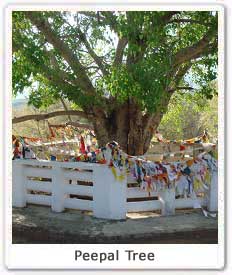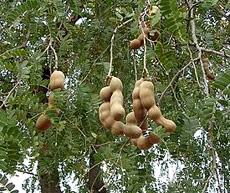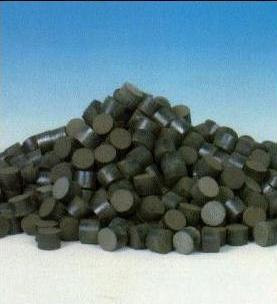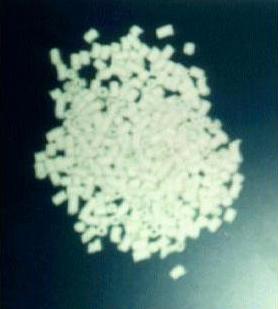What is Tulsi (Holy Basil)?
"The Queen of Herbs" - is the most sacred herb of India. Tulsi (Ocimum sanctum), although also known as Holy Basil, is a different plant from the pesto variety of Basil (Ocimum basilicum). Tulsi has been revered in India for over five thousand years, as a healing balm for body, mind and spirit, and is known to bestow an amazing number of health benefits. ORGANIC INDIA is pleased to offer Organic Tulsi, for the first time, as a stress-relieving, energizing and delicious tea. For our ORGANIC INDIA Tulsi Tea Collection we utilize a proprietary combination of 3 varieties of Tulsi: Rama Tulsi (Ocimum sanctum), Krishna Tulsi (Ocimum sanctum) and Vana Tulsi (Ocimum gratissimum). Each variety lends its own distinct and characteristic taste that contributes to the delicious flavor and aroma of our blend.What are the health benefits of Tulsi?
Tulsi is rich in antioxidant and renowned for its restorative powers, Tulsi has several benefits:- Relieves stress / adaptogen
- Bolsters immunity
- Enhances stamina
- Provides support during cold season
- Promotes healthy metabolism
- A natural immuno-modulator
"Modern scientific research offers impressive evidence that Tulsi reduces stress, enhances stamina, relieves inflammation, lowers cholesterol, eliminates toxins, protects against radiation, prevents gastric ulcers, lowers fevers, improves digestion and provides a rich supply of antioxidants and other nutrients. Tulsi is especially effective in supporting the heart, blood vessels, liver and lungs and also regulates blood pressure and blood sugar." Dr. Ralph Miller, former Director of Research for the Canadian Dept. of Health and Welfare.
How can Tulsi offer so many health benefits?
The unique chemistry of Tulsi is highly complex. Tulsi contains hundreds of beneficial compounds known as phyto-chemicals. Working together, these compounds possess strong antioxidant, antibacterial, antiviral, adaptogenic, and immune-enhancing properties that promote general health and support the body's natural defense against stress and diseases. The essential oils in the leaves of Tulsi that contribute to the fragrance and refreshing flavor of Tulsi Tea, are a particularly rich source of valuable phyto-chemicals.What is an adaptogen?
An adaptogen is an agent that helps the body adapt more efficiently to stress. Adaptogens reduce the intensity and negative impact of the stress caused by mental tension, emotional difficulties, poor lifestyle habits, disease and infection, pollution and other factors. Tulsi is one of the most effective adaptogens known.What are antioxidants?
Antioxidants slow down the process of excess oxidation and protect cells from the damage caused by free radicals. When cells are attacked by free radicals, excess oxidation occurs which damage and destroy cells. Antioxidants stop this process. The cellular damage caused by free radicals can be responsible for causing and/or accelerating many diseases. Tulsi is rich in antioxidants and is recommended to guard against free radicals and protect from damaging excess oxidation.What is an immuno-modulator?
An immuno-modulator is an agent that balances and improves the immune response of the body in fighting antigens (disease causing agents such as bacteria, viruses, microbes, allergens etc.) and maintaining health.How soon can I expect to see results from drinking ORGANIC INDIA Tulsi Teas?
Some of Tulsi effects are quite immediate, while others develop gradually after weeks of regular use. For example, you may feel more relaxed and energized after the first cup. Although Tulsi has many specific effects on different body systems, its main benefits arise from its impressive general capacity to assist the body's natural process of healing and maintaining health. Tulsi overall health promotion and disease prevention effects are powerful, but often subtle. For example, you may simply notice that you do not seem to be bothered by stress or common illnesses, such as colds or flu, nearly as often as before. Or you may notice that you generally tire less easily. As with many other herbal supplements, it usually takes at least a week or so of consistent use for the body to experience major benefits.What will Tulsi-Holy Basil do for me?
Tulsi is known as an adaptogen, helping our bodies "adapt" to different forms of stressors (environmental, physical, mental, emotional). Tulsi works for each person differently depending on what his or her body needs. Drinking Tulsi Tea promotes a sense of well-being, relieves stress, supports immunity, strength and stamina, provides relief from cold, fever and flu symptoms, and strengthens digestion and a healthy metabolism that may promote weight loss. This herbal panacea is The Herb for Our Times!How many cups of ORGANIC INDIA Tulsi Tea do you recommend per day?
Tulsi Tea can be enjoyed throughout the day, from morning to night. However, even one cup of Tulsi Tea a day is beneficial. During times of illness, the quantity and the strength of ORGANIC INDIA Tulsi TEA can be increased to quicken recovery.If I have cold or flu symptoms should I consume more Tulsi?
Tulsi has been used for thousands of years to prevent and minimize the symptoms of colds and flu, to support upper respiratory health, reduce fevers and promote overall health. When utilizing Tulsi Tea to lessen the duration of colds or flu, it is suggested that you increase the amount and strength of the tea you consume. Suggested use: 2-3 tea bags per cup of tea, 3-6 times per day.Is Tulsi safe to use during pregnancy and lactation and with children?
During pregnancy and lactation, one should always consult a primary health care provider before using any herb or herbal formula. In India, eating fresh Tulsi leaves and making tea with Tulsi leaves is common with women during pregnancy and lactation. Tulsi is considered safe for use with children over the age of 2. You should consult your primary health care provider for use with younger children. Most children love Tulsi Tea!Do ORGANIC INDIA Tulsi Teas contain caffeine?
Tulsi is naturally caffeine-free. However, some of our blends contain Black Tea and Green Tea, which do contain caffeine. Please check the individual Tulsi Tea pages in the website and/or the individual packages to see caffeine content.Does Tulsi Tea have any side effects?
You might notice that you feel much better! If you need more energy and don't want caffeine or sugar, Tulsi will gently support and strengthen your energy. When feeling stressed or anxious, many report a gentle, soothing effect to their nervous systems and notice a greater clarity of mind! Tulsi Teas are considered very safe by modern scientific standards. In fact, Tulsi helps reduce the ill effects of many allopathic medicines and has proved to be beneficial for people of all ages.http://www.organicindia.com/tulsi-facts-3.php
 the month of May. The figs which contain the flowers grow in pairs just below the leaves and look like the berries. Its bark is light gray and peels in patches. Its fruit is purple in colour. It is one of the longest living trees.
the month of May. The figs which contain the flowers grow in pairs just below the leaves and look like the berries. Its bark is light gray and peels in patches. Its fruit is purple in colour. It is one of the longest living trees.  Banyan tree is a very popular tree of the country. It is one of those trees, which have wide branches and are very much able of giving shade. The biological name of banyan tree is `Ficus Benghalensists`. There are several legends associated with the origin of its name. One legend suggest that the name `Banyan` was given to a tree growing in the Persian Gulf, under which some `Banyas` or traders had built a pagoda. Banyan tree grows widely in all parts of the country. It is widely planted throughout the country and elsewhere in tropical Asia in gardens and along roads for shade.
Banyan tree is a very popular tree of the country. It is one of those trees, which have wide branches and are very much able of giving shade. The biological name of banyan tree is `Ficus Benghalensists`. There are several legends associated with the origin of its name. One legend suggest that the name `Banyan` was given to a tree growing in the Persian Gulf, under which some `Banyas` or traders had built a pagoda. Banyan tree grows widely in all parts of the country. It is widely planted throughout the country and elsewhere in tropical Asia in gardens and along roads for shade. 
 A mixture or a decoction of the fresh Neem leaves is an acrid vegetable vitaliser and remedial, particularly in acute malarial fevers, because of its action mechanism on the liver. It should be taken in dosages of 15 to 60 grams. The use of 3 grams of the inner bark of neem with 6 grams of jaggery each morning is very efficacious for piles. To arrest bleeding piles, 3 or 4 Neem fruits can be taken with water. Leprosy can also be healed by Neem. The sap of the Neem tree has been found to be pretty active for leprosy, when taken in regular dosages. Simultaneously the patient`s body should be massaged with the sap. This schedule should be continued for 40 days. If sap is not obtainable, 120grams of Neem leaves and three decigrams of pepper can be mashed in water and taken.
A mixture or a decoction of the fresh Neem leaves is an acrid vegetable vitaliser and remedial, particularly in acute malarial fevers, because of its action mechanism on the liver. It should be taken in dosages of 15 to 60 grams. The use of 3 grams of the inner bark of neem with 6 grams of jaggery each morning is very efficacious for piles. To arrest bleeding piles, 3 or 4 Neem fruits can be taken with water. Leprosy can also be healed by Neem. The sap of the Neem tree has been found to be pretty active for leprosy, when taken in regular dosages. Simultaneously the patient`s body should be massaged with the sap. This schedule should be continued for 40 days. If sap is not obtainable, 120grams of Neem leaves and three decigrams of pepper can be mashed in water and taken.  The `Casuarina Tree` is a nice tree that has small cones and big, straight stem. This tree is a quick-growing one and lives for quite a long period. This is a hardy tree and the sandy-soil of the sea-coast areas is most suitable for the tree. It has been cultivated all through the South India to retrieve the sandy seashore. In the North Kannad and particularly along the Coromandel Coast, it grows extensively for fuel. It can make a good, solid hedge if you plant it closely and keep it low. People in the coastal districts and inland regions often use this tree as a roadside or garden tree as it is an enormously decorative and useful tree. In fact gardeners cultivate it as a hot-house plant to meet the decorative purposes only.
The `Casuarina Tree` is a nice tree that has small cones and big, straight stem. This tree is a quick-growing one and lives for quite a long period. This is a hardy tree and the sandy-soil of the sea-coast areas is most suitable for the tree. It has been cultivated all through the South India to retrieve the sandy seashore. In the North Kannad and particularly along the Coromandel Coast, it grows extensively for fuel. It can make a good, solid hedge if you plant it closely and keep it low. People in the coastal districts and inland regions often use this tree as a roadside or garden tree as it is an enormously decorative and useful tree. In fact gardeners cultivate it as a hot-house plant to meet the decorative purposes only.  Flowers of Casuarina Tree
Flowers of Casuarina Tree


 Coconut Palm Tree is considered as one of the most important and useful tree amongst all the trees of India. Originated from the Cocos Island, the tree bears the scientific name of `Cocos Nucifera`. The name `Cocos` came from a Portuguese word that means `monkey` and `Nucifera` means `bearing nuts`. The tree belongs to the `Palmae` family. It has a lot of names in various vernacular languages in India. Like for instance, in Hindi, it is called as `Narial`. It is `Narikel` in Bengali. The Tamil people named it as `Thennai Maram` and in Telugu; it got three different names like `Nari Kadam`, `Kobari` and `Tenkai`. The tree is known as `Tenga` or `Thengu` in Malayalam.
Coconut Palm Tree is considered as one of the most important and useful tree amongst all the trees of India. Originated from the Cocos Island, the tree bears the scientific name of `Cocos Nucifera`. The name `Cocos` came from a Portuguese word that means `monkey` and `Nucifera` means `bearing nuts`. The tree belongs to the `Palmae` family. It has a lot of names in various vernacular languages in India. Like for instance, in Hindi, it is called as `Narial`. It is `Narikel` in Bengali. The Tamil people named it as `Thennai Maram` and in Telugu; it got three different names like `Nari Kadam`, `Kobari` and `Tenkai`. The tree is known as `Tenga` or `Thengu` in Malayalam. 













































 Brown rice (husked rice)
Brown rice (husked rice)